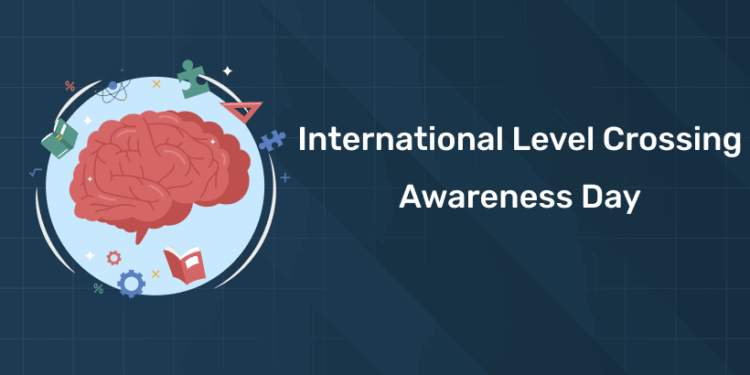Table of Contents
Every year, millions lose their lives across the world at level crossings. The level crossings are where road and railway tracks intersect. Every year over 6,000 deaths occur in the world at level crossings. Universally level crossing fatalities are but a small percentage of the total number of road fatalities. The highest percentage of the level crossing fatality was reported from Slovenia at just 3.24%. In India, there were 1,788 level crossing accidents in 2019, up from 1,408 in 2018., and among them 1,762 were dead. India had a 1.93 per cent Crossing fatalities
per million population. Around the world, the level crossing deaths rate is increasing alarmingly with each passing year. To raise awareness against this issue and to improve the level of crossing safety the International Level Crossing Awareness Day (ILCAD) is organized annually in June across the world. The ILCAD campaign has been spearheaded by the Union Internationale des Chemins de Fer or the International Union of Railways (UIC), the worldwide railway organization with the support of the railway community worldwide.
International Level Crossing Awareness Day 2025 Date – June 6
In this article readers can get a glimpse on
- History and Objective of International Level Crossing Awareness Day
- International Level Crossing Awareness Day Theme 2025
- International Level Crossing Awareness Day Quiz
International Level Crossing Awareness Day 2025
1: Who was the first woman President of India?
A level crossing is a junction where a railway line intersects with a road or, in rare cases, an airport runway. Globally, a significant portion of railway-related accidents and fatalities occur at level crossings. On average, about 500–700 people lose their lives in level crossing accidents each year. In India alone, around 1,500–2,000 level crossing incidents are reported annually. While not all result in fatalities, these accidents lead to substantial loss of life and property.
International Level Crossing Awareness Day (ILCAD) 2025 is led by the International Union of Railways (UIC), in collaboration with road safety organizations and institutions like the United Nations Economic Commission for Europe (UNECE). Launched in 2009 with the support of European countries and Israel, ILCAD has grown into a global campaign to raise awareness about safety at level crossings. The first event, held on June 25, 2009, involved 28 countries and marked the beginning of this worldwide initiative. Today, ILCAD serves as a joint commitment to promote safe behavior and reduce accidents through education and community outreach.
With over 40 countries participating annually, ILCAD campaigns include online webinars, school programs, public service announcements, and on-site safety drills. Around 25% of railway-related accidents and 2% of fatalities happen at level crossings, making ILCAD’s mission critical. In recent years, the campaign has focused on issues like distraction, impatience, and misuse of crossings. International Level Crossing Awareness Day 2025 continues these efforts, working to engage both pedestrians and drivers in adopting responsible behaviors. The observance plays a crucial role in protecting lives by promoting vigilance and safety at level crossings worldwide.
Level crossing Accidents in India
Indian Railways has 64460 route Kilometres making it one of the largest railway network in the world. In a country like India where several unmanned level crossings and thousands of kilometres of rail paths through the human settlements the safety awareness is necessary. In 2019, there were 1,788 level crossing accidents, up from 1,408 in the previous year. During the period of 2010-11 and 2019-20, level crossing-related mishaps accounted for 36 per cent of all fatalities caused by consequential accidents. The number of deaths in 2020 was also alarming. Even though the railway has decided to shut down all unmanned railway crossings, and to improve safety the death rate is yet to bring down.
Free UPSKILLING Courses!
Take your first step toward mastering in-demand skills, acing interviews, and securing top-tier jobs with Entri's free upskilling courses.
Start Learning!History and Objective of International Level Crossing Awareness Day
International Level Crossing Awareness Day (ILCAD) was established in 2009 as a global initiative to improve safety at level crossings. The idea was first implemented by the International Union of Railways (UIC) in collaboration with European railway and road safety authorities. The first official observance took place on June 25, 2009, with participation from 28 countries. It was inspired by the success of regional safety campaigns and the growing need to address avoidable accidents at railway-road intersections. Since then, ILCAD has evolved into a worldwide event involving over 40 countries each year.
The main objective of ILCAD is to raise public awareness about the risks at level crossings and encourage safe behavior by all users—drivers, cyclists, and pedestrians. It focuses on educating people through targeted campaigns, safety drills, and community outreach programs. Each year, the campaign highlights specific challenges such as distraction, impatience, or risky behavior near tracks. By promoting responsibility and vigilance, ILCAD aims to reduce the number of accidents and fatalities globally. It also encourages governments, institutions, and the transport sector to invest in safer infrastructure and preventive measures.
International Level Crossing Awareness Day Theme 2025
The 17th International Level Crossing Awareness Day (ILCAD) in 2025 focuses on the crucial theme of “Helping people make good decisions,” underscored by the resounding slogan, “Safe decisions – every time.” This global initiative, spearheaded by the International Union of Railways (UIC), aims to significantly reduce incidents and fatalities at level crossings worldwide by empowering individuals to act responsibly and safely.
Launched on June 5, 2025, in York, UK, at the National Railway Museum, in partnership with Network Rail and RSSB (Rail Safety and Standards Board), ILCAD 2025 comes at a particularly fitting time, marking the 200th anniversary of the world’s first passenger railway. The choice of the UK, the birthplace of railways, as the launch host highlights the enduring global commitment to rail safety.
The core of this year’s theme acknowledges that the vast majority of collisions at level crossings occur due to human error – individuals taking deliberate risks, making poor judgments, or being distracted. To combat this, ILCAD 2025 emphasizes a multi-faceted approach:
- Engineering Solutions: Exploring new technologies and innovations that can enhance safety at level crossings, helping to guide users towards making correct decisions and preventing accidents.
- Enforcement Partnerships: Fostering collaboration between railway authorities, local government bodies, and police forces to ensure compliance with safety regulations and encourage responsible behavior.
- Community Outreach: Developing and implementing effective educational programs, particularly targeting vulnerable users such as children, the elderly, and those with disabilities, to ensure they understand the inherent risks at level crossings. Storytelling, using real-life examples from past incidents, is a vital tool in preserving corporate memory and learning from mistakes.
ILCAD 2025, with participation from approximately 50 countries, serves as a vital platform for sharing best practices, innovative projects, and successful strategies in level crossing safety. The overarching message is clear: safety at level crossings is a shared responsibility, requiring concerted efforts from both the road and rail sectors, relevant authorities, and most importantly, every individual who encounters these interfaces. By focusing on “Helping people make good decisions” and promoting “Safe decisions – every time,” ILCAD 2025 strives to create a safer rail environment for all.
International Level Crossing Awareness Day Previous Themes
International Level Crossing Awareness Day (ILCAD), observed annually in June (often around June 5 or 6, but the precise date of the main launch event can vary), is a global initiative spearheaded by the International Union of Railways (UIC). It aims to raise public awareness of the dangers at level crossings and promote safe behavior among road users and pedestrians. While not a UN-designated day in the same vein as some others, it is a significant international safety campaign.
Each year, ILCAD features a specific theme or slogan to highlight a particular aspect of level crossing safety.
Here are the themes and slogans from recent years, as provided by the UIC and ILCAD organizers:
- 2015: “Take your time don’t risk your life!”
- 2016: “Do not overestimate your capacities near railway tracks.”
- 2017: “Distraction.” (Campaign focused on avoiding distractions at level crossings).
- 2018: “Engineering, Education, and Enforcement.” (While not a single slogan, these were the key pillars of the campaign).
- 2019: “Safety at level crossings is a shared responsibility.”
- 2020: “Distraction kills!” (This was a strong motto, emphasizing the dangers of distraction at crossings).
- 2021: Theme: “Distraction.” Motto: “Distraction kills!”
- 2022: Theme: “Maintain your personal safety at and around level crossings.” Motto: “Safety at Level Crossings: Be Aware, Stay Safe.”
- 2023: Theme: “Agricultural and industrial level crossing users.” Motto: “Tracks are for Trains.”
- 2024: Theme: “Vulnerable people.” Slogan: “Beware of trains. Life can change in a split second.”
Free UPSKILLING Courses!
Take your first step toward mastering in-demand skills, acing interviews, and securing top-tier jobs with Entri's free upskilling courses.
Start Learning!International Level Crossing Awareness Day Quiz 2025
A) Africa
B) Asia
C) Europe
3. What percentage of accidents at level crossings are caused by road user behavior?
A) 30%
B) 60%
C) Over 90%
A) Horn sounds
B) Red lights and barriers
C) Speed bumps
5. Which type of vehicle is most involved in level crossing incidents?
A) Bicycles
B) School buses
C) Cars and trucks
A) Every hour
B) Every 10 minutes
C) Every second day
A) World Health Organization
B) International Union of Railways
C) World Bank
A) Speed up and cross
B) Look both ways and cross carefully
C) Wait for someone to signal
A) To promote train use
B) To reduce train delays
C) To raise awareness and prevent level crossing accidents
Want More Engaging Questions?
Download our FREE PDF packed with insightful quiz questions to test your knowledge!
🔽 Click below to get your free copy now! 🔽
International Level Crossing Awareness Day Quiz 2025 PDF
International Level Crossing Awareness Day serves as a vital reminder of the dangers posed by railway level crossings and the importance of adopting safe behaviors. With hundreds of lives lost globally each year due to preventable accidents at these intersections, the observance plays a crucial role in promoting public education and awareness. By targeting key issues such as distraction, impatience, and ignorance of safety rules, ILCAD helps reduce risks for both road users and railway personnel. Its global reach ensures that communities across continents unite under a common cause—saving lives through responsible action.
As urbanization increases and transportation networks grow busier, the relevance of ILCAD continues to rise. The initiative’s success lies in its collaborative approach, bringing together governments, rail authorities, schools, and the public. Through consistent messaging and community engagement, ILCAD reinforces the idea that level crossing safety is a shared responsibility. With each passing year, the campaign inspires safer habits and calls for continued investment in infrastructure, education, and enforcement. Ultimately, ILCAD helps build a culture of safety that protects lives and fosters respect for railway operations worldwide.
Start your Current Affairs and General Studies preparations today itself with Entri’s free materials. India’s Leading learning Platform, ENTRI will help you with mock tests, study schedule, exam updates, video classes, personal mentorship and discussion forums. Download our free Monthly General Awareness PDFs to boost your test preparations.
Free UPSKILLING Courses!
Take your first step toward mastering in-demand skills, acing interviews, and securing top-tier jobs with Entri's free upskilling courses.
Start Learning!Frequently Asked Questions
What is International Level Crossing Awareness Day?
International Level Crossing Awareness Day (ILCAD) is a global initiative to promote safety at level crossings. It is coordinated by the International Union of Railways (UIC). The day aims to reduce accidents and fatalities where roads cross railway tracks. Awareness campaigns are organized in over 50 countries. The focus is on educating both pedestrians and drivers.
Why are level crossings dangerous?
Level crossings are intersections where roadways and railways meet at the same level. These locations pose risks due to high-speed train traffic and inattentive road users. Many accidents occur when vehicles try to beat closing barriers. Misjudgment, distraction, and impatience often lead to tragic outcomes. Proper safety measures and awareness can help prevent such incidents.
How is ILCAD observed around the world?
ILCAD is marked with awareness campaigns, school visits, media broadcasts, and community events. Rail and road authorities share safety tips and statistics. Some countries conduct simulations and training exercises. Educational posters and social media content are also released. The goal is to create lasting safety behavior among all users.
Who coordinates International Level Crossing Awareness Day?
The International Union of Railways (UIC) coordinates ILCAD. The UIC works with global partners including road and rail authorities. Its mission is to enhance transport safety worldwide. ILCAD is one of its key public safety initiatives. Countries voluntarily join the campaign each year.
What are the common causes of level crossing accidents?
Most level crossing accidents are caused by road user errors. These include ignoring signals, crossing when gates are down, or stopping on the tracks. Distraction due to mobile phones or loud music also contributes. Sometimes, poor infrastructure or lack of signage plays a role. Education and enforcement are critical to preventing these issues.
What safety precautions should drivers follow at level crossings?
Drivers should always slow down when approaching a level crossing. They must obey warning signals and never try to beat a train. If lights are flashing or gates are closing, they must stop. Vehicles should never stop on the tracks. Extra caution is needed at unguarded crossings.
Are pedestrians also at risk at level crossings?
Yes, pedestrians face serious dangers if they misuse level crossings. Crossing when gates are down or listening to music can impair awareness. Trains move fast and may not be heard until it’s too late. Pedestrians must look both ways and follow signals. Education campaigns also target pedestrian safety.
What role do governments play in ILCAD?
Governments support ILCAD through infrastructure development and public safety initiatives. They enforce traffic laws and fund level crossing upgrades. Many also partner with schools and transport authorities. Their involvement helps spread the safety message widely. Public-private collaboration improves overall campaign effectiveness.
Why is ILCAD important for schoolchildren and youth?
Children are often unaware of the dangers at railway crossings. They may play near tracks or cross carelessly without understanding risks. ILCAD includes school outreach programs to educate them early. Animated videos, booklets, and safety talks are common tools. Teaching children now can prevent future accidents.
What improvements help reduce accidents at level crossings?
Better signage, clear road markings, and automatic gates improve safety. Installing CCTV and speed detection systems also helps monitor violations. In some areas, replacing crossings with bridges or underpasses is done. Public awareness and behavioral change are key components. Combining technology and education leads to lasting improvements.











